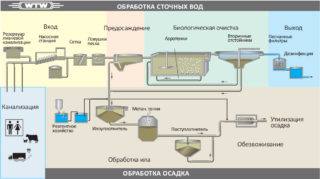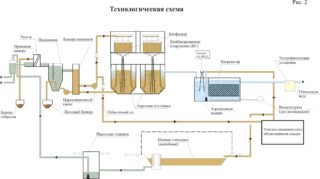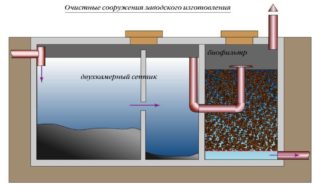High-quality wastewater treatment allows obtaining 98% purified water at the outlet. In the future, it can be used for household purposes (watering, irrigation). In private estates, an autonomous wastewater treatment plant for a cottage and other individual buildings is in demand. At industrial facilities, these are entire stations operating in a continuous mode.
Definition and operating principle of VOCs
The principle of operation of all VOCs in the first stages is almost the same:
- Mechanical wastewater treatment. Primary dirty water is freed from large suspensions and household waste, feces. All of them settle to the bottom or rise to the surface in special sedimentation tanks (depending on the weight of impurities).
- Waste water, freed from large debris, is sent to the second tank, where grease traps are switched on. They free water from oil films and oily substances.
- Sewage cleared of coarse suspended matter and grease is called "gray waste". At this stage, they are treated with bacteria, which turn the residual waste into sludge and issue clarified water at the outlet. In local treatment facilities for industrial enterprises, it is possible to achieve almost 100% of effluent clarification. It is important to remember that in winter, at low temperatures, the rate of bacteria's work is seriously reduced. In this case, volatile aero tanks are selected and connected to the case.
- Treated industrial water is subjected to additional treatment with chemicals according to the developed scheme. This is done for the final neutralization of impurities in the form of undissolved particles of debris, decay products of fats, etc. Flotators and coagulants are often used in industrial VOCs.
As a rule, in domestic septic tanks, the first two or three stages of wastewater treatment are often used. Subsequently, the clarified water is drained into the ground. When installing a home VOC, you need to calculate the volume of effluent. It is equal to 200 liters of water per 1 family member per month.
Advantages and disadvantages of VOCs
- Absolute environmental friendliness. According to the law of the Russian Federation, the discharge of industrial / household waste and sewage into water bodies is prohibited. This is a criminal and administrative offense. With the help of VOCs, it is possible to bring polluted water into a state of effluent permissible for discharge.
- Lack of a specific smell on a private plot (only for own households).
- Relative ease of installation. It is enough to prepare the foundation pit and mount the tanks.
- Durability. If plastic tanks or volatile aeration tanks are installed in the ground, they serve for 50 years or more.
- Saving the family budget on the services of a sewer. A home septic tank can be cleaned no more than once every six months or a year.
The relative disadvantages include the energy dependence of aeration tanks and the need for costs for the acquisition of an autonomous structure. But they pay off already in the first or second year of VOC operation.
Types of structures
- Standard cesspool. It is a reservoir formed in the ground and lined with bricks from the inside. In an improved version, a plastic container is installed in the pit to collect wastewater. In the future, a sewer is used to pump them out. This is the main disadvantage of a cesspool besides soil contamination in the absence of a sealed bottom.
- Septic tank. A special design of two or three chambers, in which there is a stage-by-stage wastewater treatment.
- VOC. Local purification system powered by electricity. It has a multi-stage wastewater clarification and filtration system.
The last option is the most environmentally friendly. At the outlet, water is obtained clarified by 98-100%, suitable for safe discharge into the environment or for further use on the farm.
Varieties of treatment systems
There are three types of local treatment systems:
- Industrial. They are huge stations, consisting of several workshops. Designed for treatment of effluents from factories, manufacturing plants, pharmaceutical / chemical complexes.
- Domestic and household sewage VOCs. They are connected to a common highway and are often located outside the village. Such structures also have impressive dimensions and are serviced by whole shifts of workers.
- Household. Standard septic tank for private use. It is used if it is not possible to connect to the city sewage system.
For living conditions, they often purchase ready-made septic tanks made of plastic. However, there are also those homeowners who prefer to independently mount the receiver-tanks made of concrete, brick, car tires.
VOCs for industrial plants

Industrial wastewater treatment systems are impressive in size and often consist of several huge workshops. In each of them, separate stages of treatment of contaminated effluents with special chemicals and reagents take place. The need for such treatment lies in the fact that industrial waters contain more aggressive suspensions and impurities. Accordingly, the same aggressive reagents are used to purify such effluents. With their help, it is possible to purify dirty water from such enterprises:
- creameries and meat processing plants;
- chemical and pharmaceutical industry;
- breweries and canneries;
- poultry farms;
- glass, automobile factories, etc.
Each of the stages of cleaning takes place in a special separate pool. This allows you to monitor the efficiency of the process.
At most VOCs for industrial use, the UV method is used instead of the usual chlorine as the final stage of disinfection of clarified water - treatment of light effluents with ultraviolet light.
VOC for storm water

Rain and snow water require no less thorough cleaning before being discharged into the ground and water bodies. Storm runoffs contain chemical impurities in the form of dissolved reagents (used for asphalt roads in winter in icy conditions), the inclusion of household chemicals and automobile oils removed from the buildings of car washes, car services, etc. In addition, rainwater contains sand with earth, which is also needed pre-remove from drains.
Structurally, the atmospheric water purification system looks like this:
- storm water inlet in the form of a special tank with an upper grate;
- trays and gutters in the form of an extended collector;
- wastewater receiver, it is also a sump.
In the sedimentation tank, the storm drains are subsequently cleaned. Later they are dumped into the ground or water bodies.
VOCs for stormwater treatment are necessarily equipped with special sand traps and grates. They help prevent large debris, sand and soil particles from entering the collector.
Standalone VOC prices
The cost of industrial treatment facilities is estimated at millions of rubles.Prices for private sewage treatment plants:
| VOC name | Manufacturing material | Dimensions (m) LxWxH | Number of people served | Price, rub.) |
| Tver-0.75 P | Polypropylene | 2.25x0.85x1.76 | 3 | 69 800 |
| Tver 1P | Polypropylene | 2.5x1.1x1.67 | 5 | 88 000 |
| Tver 2P | Polypropylene | 4x1.3x1.67 | 10 | 131 000 |
| Tver 3P | Polypropylene | 4x1.6x1.67 | 15 | 151 000 |
| Tver 6P | Polypropylene | 4x1.6x1.67 | 20-30 | 300 000 |
The prices of mini-treatment facilities for the home may vary depending on the region and the manufacturer of the system, but on average correspond to those indicated in the table.











